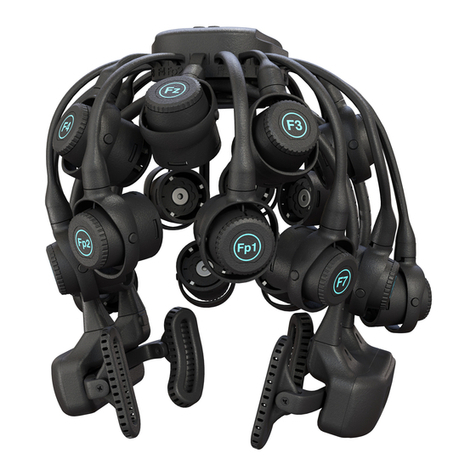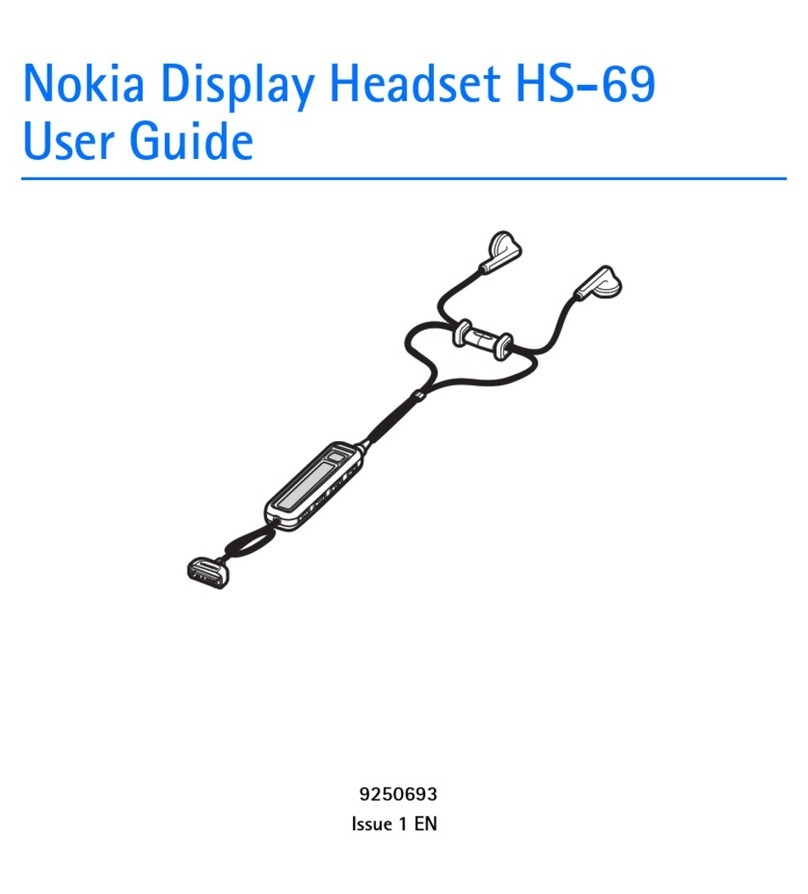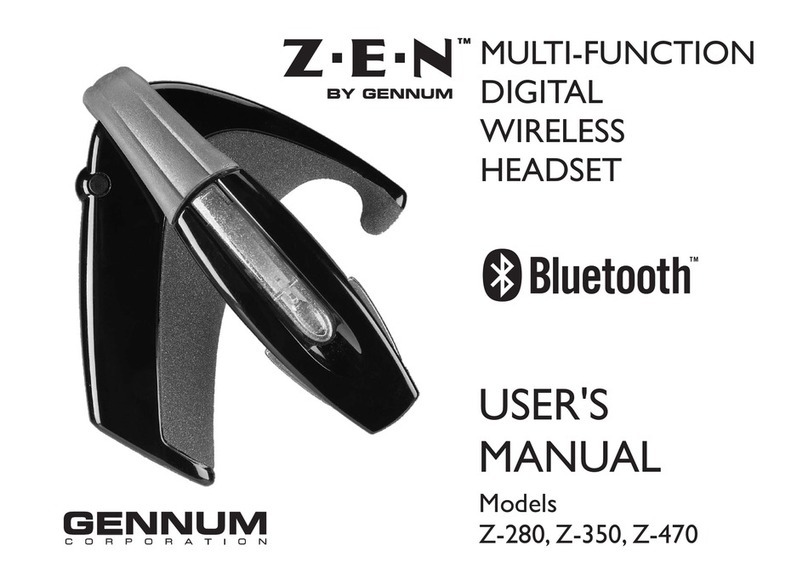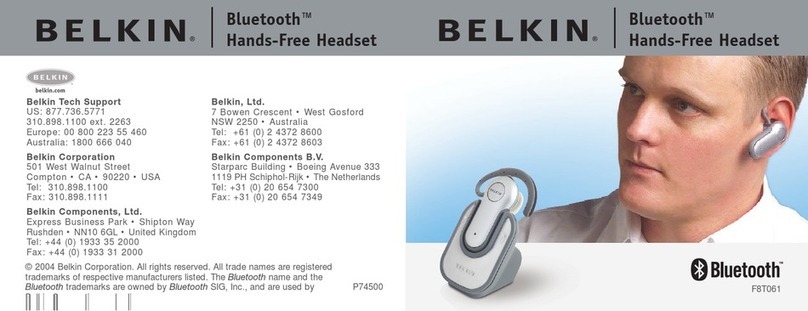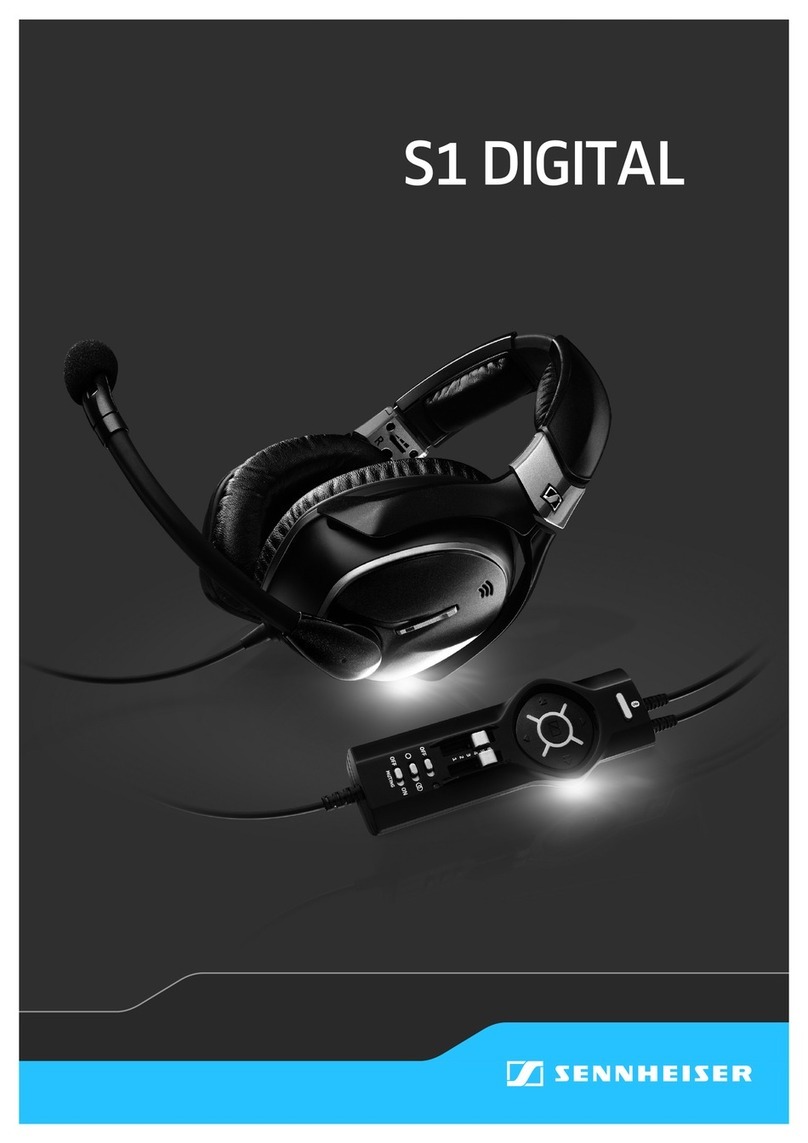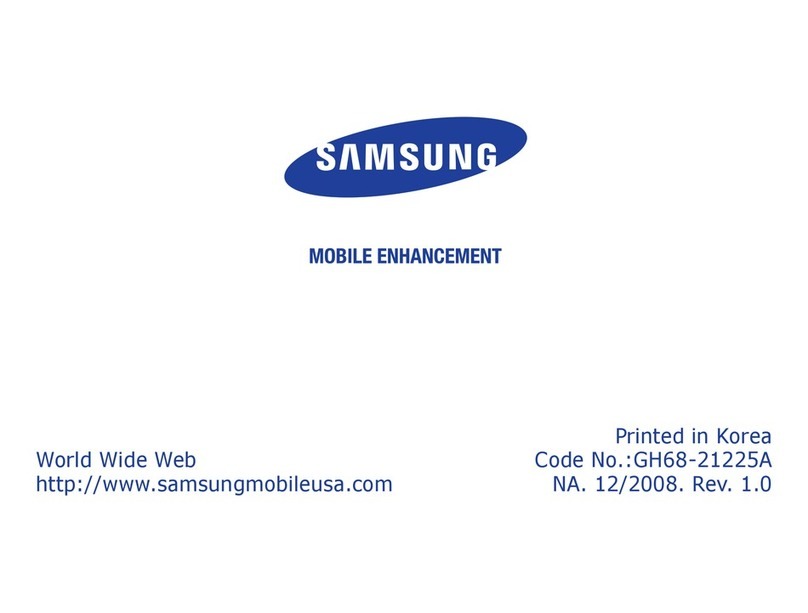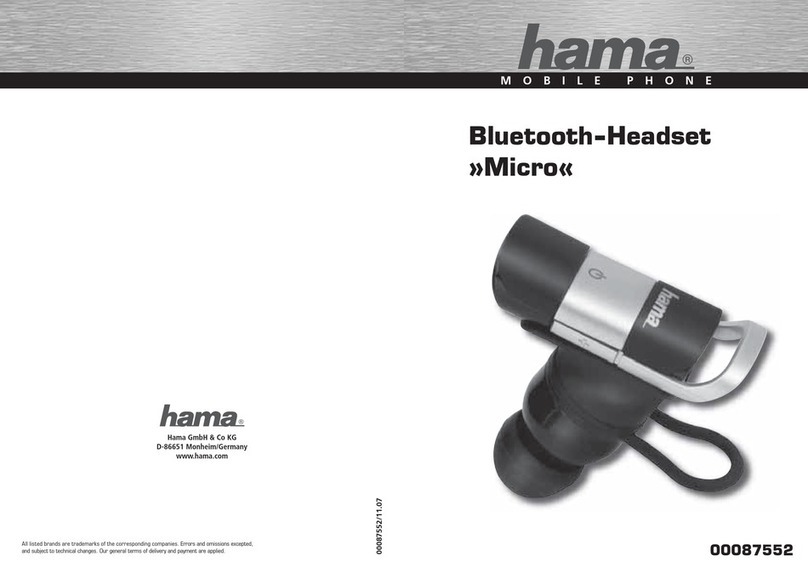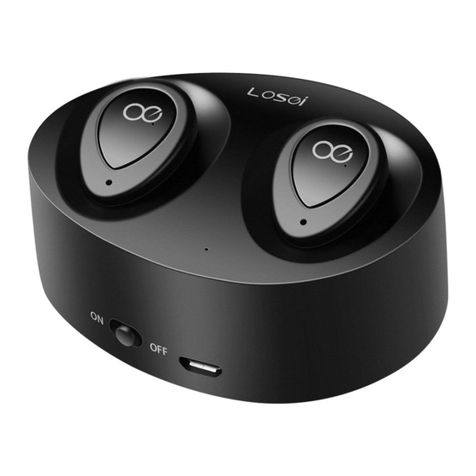CGX Quick-32r User manual

Quick-32r
This manual contains general operating instructions, precautionary measures,
maintenance instructions, and information for use of the CGX Quick-32r.
Please read this manual carefully and familiarize yourself with the controls and
accessories before using the product.
Note
• This is an investigational device designed for research and development eorts.
• It is not an FDA-approved medical device.
• There are no known side eects from the use of this product.
CGX A Cognionics Company
Description
The Quick-32r is a wireless, battery-
operated EEG headset utilizing dry
sensor technology. Channel positions
are arranged in an enhanced 10-20
montage with 10 additional fixed EEG
channels on the head, plus 2 variable-
placement ExG channels.
The headset provides an integrated
approach to the wireless acquisition
of recorded of EEG signals. Wireless
technology allows the subject to move
about while real-time data is collected
and displayed.
The headset obtains high-quality
EEG with minimal scalp preparation.
Patented mechanisms and replaceable
dry sensors align to various head
shapes and sizes, maintaining sensor
positions in a standard montage.
EEG channels are sampled at a time
resolution of 500Hz and converted to
digital data at 24 bits of resolution.
The Quick-32r provides research-
grade signal quality and is ideally
suited for general-purpose EEG and
ERP research in laboratory and field
environments.

2
Warnings
TheQuick-32risintendedtobeused
toacquiretheelectroenchephalogram
(EEG)andtransmititwirelesslytoa
computer.
ThisDeviceIsIntendedForResearchOnly.
ItIsNotIntendedForTheFollowingUses:
• monitoring of patients in a clinical
environment
• use in medical diagnosis
• on subjects undergoing surgery
• use in sterile environments
• use with sleeping subjects
DoNotUseThisProductInThese
Situations:
• near high-frequency surgical equipment
• if exposed to ionizing radiation
• in oxygen-rich environments (concentration
> 25% at 1 atm)
• in wet environments
• in the presence of ammable anesthetics
or gases
PrecautionsForThePractitioner
• Do not drop, sit on, step on, fold, push,
pull or stretch the product.
• Check if your subject has a sensitive
dermatological condition causing sensor
intolerance.
• To avoid cross-subject contamination, do
not use with subjects having open wounds
or scalp infections.
• The Quick-32r headset is not a diagnostic
tool. Any medical diagnosis related to
the EEG should be derived by a certied
physician.
SubjectConsiderations
• This device is intended for human use only.
• Subject should have a healthy scalp.
• This device ts teens and adults with a
head circumference from 52 to 62 cm.
• Do not use with infants or neonates.
• Test subjects may or may not have hair.
• All sensors must be able to contact the
subject’s scalp.
• The entire headset may come into contact
with the subject’s skin.
FollowTheseAdvisoriesToKeepYour
Quick-32rInGoodWorkingOrder
• Do not immerse the headset in liquid.
• Do not expose the headset to direct
sunlight or heat source, moisture, vibration,
mechanical shock, excessive dust, or
humidity.
• Do not open, modify or disassemble the
headset — this will void the warranty.
• Do not use if the headset is damaged.
• Do not use when wet — if moisture
penetrates the headset, remove the
batteries and let it thoroughly dry prior to
use.
• Do not use caustic or abrasive cleaners on
the headset or sensors.
• Avoid sharply bending the legs.
DisposableSensorsMayBeA
Biohazard
• Store clean sensors in the provided jars.
• Clean sensors after each session following
instructions on Page 13.
• Replace sensors at or before their stated
lifecycle limits (Specications, Page 26), or
if they appear worn.
AlwaysUseSuppliedAccessories
Using accessories other than those supplied
with your Quick-32r system may result in
damage or diminished ecacy of the system.
The Quick-32r uses two AA Alkaline or
NiMH batteries. Follow care and handling
instructions provided by the battery
manufacturer.
AvoidCross-SubjectContamination
Clean the device and clean or replace
sensors after use following the cleaning
instructions on Page 13 to avoid cross-
subject contamination.

3
DeviceOverview
Quick-32rOverview
EEG is the measurement — through the use of sensors and
ampliers — of scalp surface electrical potentials arising
from activity in the cortex.
The Quick-32r follows an enhanced international 10-20
system standardizing 30 electrode placements across
the scalp. The 10-20 system derives its name from
measurements of 10% and 20% of the distance between
landmarks on the head, specically, the depression above
the bridge of the nose (nasion), the bump at the back of
the head (inion), and the depressions in front of each ear
(preauricular points).
Sensors are labeled with a combination of letters and
numbers indicating their respective locations, with even
numbers on the right and odd numbers on the left side of
the head. Midline locations are marked with a “z” for “zero.”
For instance, Fz sits on the frontal midline, while F3 sits left
of and F4 sits right of Fz.
The Quick-32r is sized to t most adult head sizes. See
sizing chart on Page 27.
The Quick-32r meets the
mechanical, electrical, and
sensor needs required to
make an eective dry EEG
system.
Conventional wet systems
rely on electrolytic gels
to penetrate hair, contact
the skin, and provide a
conductive path. The gel
serves as a buer lling in
gaps between the sensor and
skin.
No conductive gel is used in a
dry system. The benets are
obvious: faster set-up, and no
after-use clean-up required.
Yet, dry systems are subject
to several challenges. First,
the sensor must be designed
to directly touch the scalp or
skin, even through thick hair.
Second, the sensor must
remain securely in place to
minimize artifacts and noise.
Finally, the electronics must
tolerate impedances up to
200 times higher than wet
systems — while rejecting
noise and interference. A
high-end dry solution — like
the Quick-32r — balances
sensors, mechanics and
electronics achieving virtually
the same signal quality as a
traditional wet cap for most
EEG applications.

4
DeviceOverview
ThePackageContains
TheFollowingItems
Quick-32r Headset
with 2 ExG Channels
and Bluetooth Dongle
30 Drypad Sensors
60 Flex Sensors
10 Drypad Ear Sensors
A1 Earclip (left ear)
A2 Earclip (right ear)
3 Active Lead Wires
3 Passive Lead Wires
30 Skintact Sensors
5 Alcohol Wipes
4 Rechargeable AA
Batteries
Battery Charger
Carrying Case
Manual
Quick-32rHeadset
Handle
Sensor
Pods
Handle and
Battery
Compartment
Earpads
Legs
Amplier
Ground
Two ExG
channels
A2
Position
(Right Ear)
A1
Position
(Left Ear)

5
DeviceOverview
BluetoothDongle
High-speed receiver
dongle plugs into
your computer’s
USB port.
Amplifier
Wireless amplier
collects signals
and transmits to
Bluetooth Dongle.
FlexSensor
Flex sensors slide
through hair for
high-quality scalp
contact.
DrypadSensor
Drypad sensors
make direct
skin contact for
ECG and EEG
recordings.
A1Earclip
A1 left ear
earclip has two
sensor locations:
Reference and
Ground.
A2Earclip
A2 right ear earclip
is used in linked-
ears congurations.
DrypadEarSensor
Dedicated Drypad
sensors for use with
Earclips.
LeadWires
Active lead wire
(3.5mm connector)
for Reference/A1
and A2.
Passive lead
wire (touchproof
connector) for
Ground and ExG.
Active Passive

6
Preparation
1.InstallTheSoftware
Note:CGXAcquisitionsoftwarerunsonWindows
only.
• Navigate to CGXSystems.com
• Select Downloads from the top navigation menu.
• Select ClickHereForAcquisitionSoftware
• Choose the latest version link under “Downloading and
Installing the Software.”
• Extract the zipped le to your desktop.
• Run CGX Setup and follow the instructions.
• If you see a security warning, select MoreInfo and Run
Anyway
• The software will create a shortcut on your desktop.
Download the latest software
from CGXSystems.com
2.SelectSensors
Choose the appropriate sensor for your application.
Drypad Sensors
Use Drypad sensors in positions where the subject has no
hair (forehead and bald areas).
Flex Sensors
Use Flex sensors to penetrate hair.
3.AttachSensors
Sensors have a round ower pattern on the mating end
that aligns with a recessed ower pattern on the snap
connector.
• Lightly rotate the sensor until it begins to lock into the
snap connector.
• Push rmly at the center of the sensor when installing.
• For Flex sensors, do not apply pressure to, or bend the
sensor tips.
• When removing sensors, pry between the sensor and the
connector.
• Do not pull on the tips of the Flex sensors.
Drypad Sensor for
direct skin contact
Flex Sensor for hair
Sensor footprint matches
snap connector
Attach sensor
It may require extra pressure
to insert a sensor due to
variability in surface coating.
Try that sensor in an alternate
pod location in case of a
particularly tight t.

7
4.AssembleTheA1Earclip
1. Pinch the earclip to opne.
2. Insert a Drypad Ear Sensor into each hole.
3. Attach the Passive and Active Lead Wires to either snap
on the earclip.
4. Attach the Passive Lead Wire to the touchproof
connector on the A1 handle.
5. Attach the Active Lead Wire to the 3.5mm connector on
the A1 handle.
4a.(Optional)AssembleTheA2Earclip
Use the A2 Earclip for recordings requiring both ears.
6. Pinch the earclip to expose the single snap connector
and attach a Drypad Ear Sensor.
7. Attach the Active Lead Wire (3.5mm connector) to the
snap on the earclip.
8. Attach the Active Lead Wire to the 3.5mm connector on
the A2 handle.
4b.(Optional)AttachTheExGLead
For additional biometric data acquisition, attach a passive
lead wire to the touchproof connector on the A2 handle.
Preparation
Plug Passive Lead Wire
(touchproof connector) and
Active Lead Wire (3.5mm
connector) into headset,
matching orientation as shown
Active Lead Wire
Passive
Lead Wire
A1 EarclipDrypad Ear
Sensor
A1 uses a touchproof lead
wire for Ground and the
3.5mm audio jack lead wire
for Reference
Insert the Drypad Ear Sensor
into the Earclip with snap
facing out. Attach lead wire to
snap as shown.

8
Slide to open battery door
Insert 2 AA batteries as shown
Preparation
5.ChargeAndInsertTheBatteries
Use fresh alkaline batteries, or if using NiMH batteries, fully
charge before using.
• Open the battery door on the A1 handle.
• Place the batteries in the correct conguration following
the markings inside the battery housing.
6.CheckPowerStatusandTriggerStatusLightsOn
TopOfAmplifier
Amplifier
Power
Status
Light
Status light
for optional
Wireless
StimTrigger
Power
Button
7.InsertBluetoothDongle
Plug the dongle into your computer and Windows should
automatically install the correct drivers. Verify driver
installation by checking the Device Manager for problems,
marked by a yellow exclamation mark.
• The dongle is specic to each headset.
• For best performance, ensure a clear line of sight
between the dongle and the front of the headset
If Windows did not successfully install the driver for
the dongle, refer to the FTDI driver installation manual
on our website.
Trigger
The Trigger Status Light is for use with the optional CGX
Wireless StimTrigger, and indicates when the headset is
receiving trigger signals from the StimTrigger unit.
PowerLight Status
O Headset O
Green Headset On
Yellow Low Battery
Red Critically Low Battery (replace immediately)
TriggerLight Status
O Trigger Out Of Range
Blue Trigger In Range

9
Preparation
8.StartTheAcquisitionSoftware
Once you’ve established a connection, data should begin
to stream.
Double click on the CGX Acquisition software icon. You
should see CGXQuick-32runder DiscoveredDevices.
If you do not see the name CGX Quick-32r, remove
and re-insert the dongle and restart the software.
1. First, click the device name in this window to select the
Quick-32r.
2. Then click Connect.
You should now see the device conguration window.
If you do not, double check to make sure the
Quick-32r is powered on.
Click StartDevice.
You will now see data streaming into the display. Click the
Channels tab on the top right-hand side of the program.
This will bring you to the impedance check. You are now
ready to use the device.
Each Quick-32r is permanently paired to a receiver dongle.
The pair automatically discover and initiate a connection
when both are powered on and within a 10m range.
The light on the dongle indicates its current state:
Dongle
Indicator light

10
DonningInstructions
OptimalHeadsetPlacement
Fp1 and Fp2 sensor
pods resting 1cm
above the eyebrows
Crown sitting directly on
top of head
No legs or pods are
tilted or misaligned
Ask the subject for any areas of discomfort and reposition the
sensors to lay at on the head, if necessary.
Earpads resting
securely around
ears
Headset not tilted too
far towards the back of
the head
Both earclips fully populated
A2 A1
ExG
Ground

11
9.PlaceTheQuick-32rOnTheSubject’sHead
1. Grasp each handle and gently pull them apart to open
the headset.
2. Slide the headset over the subject’s head.
3. Adjust the position of the headset so the earpads t
around the subject’s ears.
4. Brush aside excess hair near and underneath the
earpads.
5. Position Fp1 and Fp2 to sit 1cm above the eyebrows.
6. Reorient misaligned legs and pods.
7. Grasp and rotate each pod so the sensor is
perpendicular to the subject’s head.
8. Push the headset downward so the sensor at the crown
(Cz) makes rm contact with the subject’s head.
9. Ensure pods lie at on the subject’s head.
10.Brush aside excess hair on the forehead and any other
positions where Drypad sensors are installed.
11.Lift the earpad to access the ear lobe and clean with
alcohol.
12.Clip the A1 earclip to the left earlobe.
13.Option: Attach the A2 earclip to the right earlobe.
14.Option: Attach ExG passive lead wire on the A2 handle
for additional biometric measurements.
15.Verify headset is properly positioned on the subject’s
head.
Don headset front-to-
back, positioning Fp1
and Fp2 1cm above the
eyebrows
Pull down on handles
until Cz makes rm
contact with the top
of the head
Apply A1 earclip to
left earlobe
DonningInstructions

12
FinalSteps
A1 Reference and Ground
earclip must be applied for
impedance check to operate.
10.OptimizeSensorContact
After properly positioning the headset on the subject,
obtain direct contact on all sensors before recording.
The Quick-32r has impedance-level LEDs on the top
of each sensor pod. The LEDs live-check the system’s
impedance and have a threshold of 2,500 kΩ.
Use the LEDs to assist in making contact with the scalp on
each position. Then bring up the impedance check in the
CGX Data Acquisition software under the Channels tab.
The impedance check presents a color-coded map of the
sensors on the device, corresponding to contact level:
Red Impedance out of range
(>2,500 kΩ default)
Green Impedance within range
(<2,500 kΩ default)
The range of impedances with dry sensors may be higher
than what you are accustomed to when working with
conventional wet sensor ampliers. CGX devices utilize
a combination of advanced electronics, shielding, and
mechanics to obtain EEG signals even when contact is
poor, and can tolerate sensor impedance up to 2,500 kΩ.
11.AdjustPods,IfRequired,ToImprove
ImpedanceMeasurements
Check for acceptable impedance measurements on each
channel.
To ensure good impedance measurements:
Grasp pod on sides to
reposition
Gently twist
swivel mechanism without
displacing pod
ImpedanceMap
Under The Channels Tab
Unacceptable
ThresholdSpikes
You may see a brief glitch in the EEG signal when electrode
impedance nears 2,500 kΩ. This is a natural eect when
the LED on the pod changes colors. Continue adjusting the
electrode until the impedance is below the threshold and
the artifact will disappear.

13
FinalSteps
12.RecordAnEEG
After you have acceptable impedance levels, click Record
under the Device tab to begin your recording. To end the
recording, under the same tab, click StopRecording.
13.EndTheSession
Close out the current le in the software if one is active and
exit the program. Press the power button once to turn o
the device.
The headset should be placed either upside down, with the
top of the headset resting on a table top, or back into the
carrying case.
PositionOfTheSubject
DuringEEG
Use the Quick-32r headset
for subjects in an upright
position. Do not let the
subject lie or sleep on the
headset. It may damage the
headset.
CleaningAndMaintenance
To avoid cross-subject contamination, follow the cleaning
instructions to clean sensors and headset after each use.
This device is not intended to be sterilized in an autoclave.
CleaningSensors
• Use hand sanitizer or alcohol wipes to clean all sensors.
CleaningTheSensorPodsAndLegs
• Use alcohol wipes to clean sensor pods and legs.
BatteryStorage
Remove the batteries when headset is not in use.
DisposalInstructions
To protect the environment, always follow local law, rules,
and policies regarding electronic and battery disposal. You
may also return the headset to CGX for proper disposal.
Use the supplied carrying
case when transporting the
headset.
It is not recommended to
leave the Quick-32r in the
carrying case for long term
storage since the legs may
become compressed. This
will not aect functionality,
but may cause the headset to
be excessively tight on larger
heads.
To restore the shape of
your headset, place on a
mannequin head for several
hours until the legs relax.
• Gently pull down on the handles until the Cz position
reports adequate contact.
It is important the headset is seated properly in the
correct position and all legs and pods are aligned with
the subject’s head before pulling down. Failure to do
so may result in poor contact at the Cz position.
• Lift the pod slightly to move hair aside.
• Lower the pod back in place, keeping the sensor aligned
to the subject’s head.
• Gently twist the sensor adjustment back and forth to help
move the sensor through the subject’s hair.
• Lightly press down on the pod, holding for 5 seconds,
then gently release the pod.

14
The most important aspect of EEG recording is that
output data is only as good as the recording input. While
algorithms exist to remove artifacts, poorly recorded data
cannot be xed in post processing.
Recording good EEG data requires preparation of the
participant for optimal sensor contact:
1. Participants should have their hair recently washed
and fully dried before recording. Wet hair, hair gel,
conditioners, and hair spray may cause interference and
degrade signal quality.
2. Clean each sensor location on the head with a cotton
swab soaked with alcohol.
3. In the event of diculty establishing good contact, apply
a small amount of water between the sensor and scalp
to create an electrical bridge.
4. It is important for subjects to reduce tension in the
head, neck, and shoulders during readings.
ObtainingCleanEEGData
TypicalCleanDataRecording
This is a representation of a
clean data recording.
Quick-32r sensor locations
lie within 1.0 centimeters on
the vast majority of hand-
measured enhanced 10-20
placements on heads sized
from 52-62 centimeters.
See sizing chart on Page 27.

15
UnderstandingReadings
Traces are thin and deviate
minimally from the axis.
CleanDataAtDefaultScale
Eye blinks will generate
muscle artifacts in the
frontopolar locations (Fp1
and Fp2) and less so in
frontal sensors (F3/F4, F7/F8),
overshadowing brain activity
in EEG recordings.
Blinks
Moving the eyes will generate
muscle artifact in the forehead
and front of the head. A high
concentration of neurons
in the eyes generate strong
electromagnetic elds, so eye
movement causes disruptions
in the EEG recording.
EyeMovement

16
Jaw clenching may aect
most or all channels,
especially if clenching hard.
Light jaw clenching or
tightness can be observed
in F7/F8, T3/T4. Take note
of any temporomandibular
joint disorders: these can
cause artifact without typical
clenching.
The tongue is a large
polarized muscle, with the
tongue’s tip negative with
respect to the base of the
tongue. When the tongue
moves around the mouth,
it generates a moving eld
causing recording disruptions.
Disruptions may be seen
down the midline (Fz, Cz, Pz).
Tongue movement during
talking can be seen on many
channels.
UnderstandingReadings
MuscleArtifact:JawClench
MuscleArtifact:TongueMovement
Swallowing invokes
movement of several muscles
in the mouth, including the
tongue, causing disruption
of many channels. Ignore
swallowing if infrequent, but
frequent swallowing may limit
usable data.
MuscleArtifact:Swallowing

17
Neck tension may aect
channels on the back of the
head, predominantly O1/O2,
but also in parietal sensors
(Pz/P3/P4, P7/P8). Subjects
should be comfortably seated,
with appropriate bracing at
the back and neck. Avoid
slouching.
Brief disruptions in contact
between sensor and scalp
may cause “sensor pops” on
recordings. Occasional pops
can usually be ignored in
processing, but if the problem
persists, check the contact
between the sensor and
scalp. Wipe popping locations
with a small amount of alcohol
on the sensor.
MuscleArtifact:NeckTension
HeadsetOrElectrodeDisruptions:SensorPops
UnderstandingReadings
Excess or quick movement
of the head may disrupt
connection between sensors
and scalp causing data
artifacts as shown.
HeadsetOrElectrodeDisruptions:HeadMovement

18
EEG sensors are sensitive
enough to detect small
electrical signals on the
cortex. Occasionally, sensors
may lie directly atop a blood
vessel. When this occurs,
sensors may detect the
subject’s pulse. Slightly move
the sensors to reduce pulse
artifacts.
Power lines operate between
50 and 60 Hz. Unsecure
power sources may leak
electromagnetic frequencies.
Because EEG records
frequencies from 1hz to about
40hz, power line noise may
negatively impact recordings
on all channels. This is
especially the case when
connection between sensor
and scalp is poor.
UnderstandingReadings
PulseArtifact
MildPowerLineArtifact
To avoid power line artifacts,
have subjects sitting at
least 3 feet from power
cords, plugged-in devices,
and lighting or overhead
uorescent lights. The
Quick-32r shields the sensors
from environmental noise,
but issues can still occur
with poor skin contact. If
power line artifacts appear
on all channels, lightly wet A1
Reference Drypad Ear Sensor.
StrongPowerLineArtifact

19
UnderstandingReadings
There are a multitude of
recording errors when the
A1 reference earclip is not
connected to the subject.
The most common are:
• Impedances match or
nearly match at a low value
but do not appear on the
display or in the impedance
head map. (g. 1)
• No traces appear and
impedance values are zero.
(g. 2)
• No traces appear and
impedance values are high.
(g. 3)
ImproperSetup:NoConnectedReference
g. 1
g. 2
g. 3

20
UnderstandingReadings
When the reference channel
is touched or jostled, all
channels will be aected.
Avoid disrupting the A1
Reference earclip during use.
When the reference is
disconnected, all channels will
disconnect as well.
ImproperSetup:ReferenceContact
ImproperSetup:ReferenceDisruption
If the ground has poor
contact, all channels will be
impacted. Avoid disrupting
the connection of the A1
Ground earclip during use.
For best results, lightly wet A1
Reference Drypad Ear Sensor.
ImproperSetup:GroundDisruption
Table of contents
Other CGX Headset manuals
